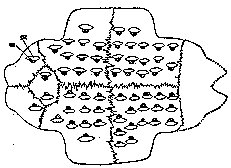|
TRANSLATIONS
The spirit of vegetation (and fauna) is what breaks the dry turtle shell (crust of the earth), and it does not happen at summer solstice - at that time the whole wonderful process is over. Instead it must come earlier, though not as early as at winter solstice (in spite of the 'breaking of the coco-nut' ceremony on Hawaii). The shell is broken by the force of the sun in spring. The key element is not his 'fire' but his 'water'. Without it the carapace will remain intact. The Chinese warped it by cracking the shell by fire: 
They played with mother nature and thought they had won. What is hard can be made soft by water. Then growth will come. It will not come by fire. Fire is the opposite process, a kind of 'life' which does not build up but destroys. At midsummer, therefore, the turtle withdraws his head into his carapace. His head does not come off, it disappears for another reason. The reason is rest, he has eaten enough. Beyond midsummer the 'turtle' will return, give back - it is the backside of the year. Honui seems to be hônu-î. We have the great statues, moaî, which word probably is an intensification of moa (the cock) - i.e. the spring sun (like a cock in the early morning). We have Vakaî, the queen pregnant with a new sun - i.e. a 'mixing vessel' (where the genetic material is randomly put together into a new constellation), and where vaka is the 'canoe' (like the ark of Noah). Ships are females. Vakaî and Moaî correspond to the Rice-bride and the Rice-bridegroom, the couple which will generate multitudes. The great turtle (Honuî) should be the chess-board, the field to play on during the non-growing season and to fill with new pieces during spring. |